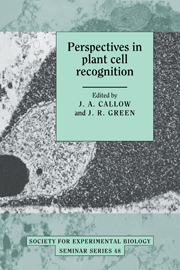Book contents
- Frontmatter
- Contents
- List of contributors
- Preface
- Sexual signalling in Chlamydomonas
- Gamete recognition and fertilisation in the fucoid algae
- The fungal surface and its role in sexual interactions
- Gamete recognition in angiosperms: model and strategy for analysis
- The molecular biology of self-incompatible responses
- Cell surface arabinogalactan proteins, arabinogalactans and plant development
- Local and systemic signalling during a plant defence response
- Contact sensing during infection by fungal pathogens
- The electrophysiology of root–zoospore interactions
- Molecular differentiation and development of the host–parasite interface in powdery mildew of pea
- Recognition signals and initiation of host responses controlling basic incompatibility between fungi and plants
- Cell surface interactions in endomycorrhizal symbiosis
- Host recognition in the Rhizobium leguminosarum–pea symbiosis
- The Rhizobium trap: root hair curling in root–nodule symbiosis
- Structure and function of Rhizobium lipopolysaccharide in relation to legume nodule development
- Index
- Plate section
Cell surface interactions in endomycorrhizal symbiosis
Published online by Cambridge University Press: 07 May 2010
- Frontmatter
- Contents
- List of contributors
- Preface
- Sexual signalling in Chlamydomonas
- Gamete recognition and fertilisation in the fucoid algae
- The fungal surface and its role in sexual interactions
- Gamete recognition in angiosperms: model and strategy for analysis
- The molecular biology of self-incompatible responses
- Cell surface arabinogalactan proteins, arabinogalactans and plant development
- Local and systemic signalling during a plant defence response
- Contact sensing during infection by fungal pathogens
- The electrophysiology of root–zoospore interactions
- Molecular differentiation and development of the host–parasite interface in powdery mildew of pea
- Recognition signals and initiation of host responses controlling basic incompatibility between fungi and plants
- Cell surface interactions in endomycorrhizal symbiosis
- Host recognition in the Rhizobium leguminosarum–pea symbiosis
- The Rhizobium trap: root hair curling in root–nodule symbiosis
- Structure and function of Rhizobium lipopolysaccharide in relation to legume nodule development
- Index
- Plate section
Summary
Mycorrhizae are the most widespread type of association established between plants and soil microorganisms. The roots of 90% of land plants associate with many soil fungi to form complex systems, whose structure and function depend on the specific combination of the eukaryotic partners. During the formation of mycorrhizae, numerous events of specificity and recognition occur at different levels: species, plant organ, root tissue and cell type.
Specificity and recognition in mycorrhizae
Among the different 260 000 plant species, 200 000–240 000 have been estimated to have the potential to form mycorrhizal associations (Law & Lewis, 1983). On the other hand, many fungal representatives of the Zygomycotina, Ascomycotina, Basidiomycotina and Deuteromycotina depend on the mycorrhizal association for the completion of their life cycle (Harley, 1989). The single word ‘mycorrhiza’ encompasses a complexity of forms of interaction, since at least six main types of mycorrhiza can be recognised (Table 1). Extensive observations indicate that some specificity exists in the interaction, as a range of compatible and incompatible hosts can be defined. According to Smith & Douglas (1987) specificity of a symbiosis refers ‘to the degree of taxonomic difference between acceptable partners and may vary from very low to high or very high’. From Table 1 it is clear that mycorrhizae have a low degree of specificity compared to other associations, as a single fungus may associate with plants of more than one class and also a single host plant may associate with different fungal endophytes.
- Type
- Chapter
- Information
- Perspectives in Plant Cell Recognition , pp. 239 - 256Publisher: Cambridge University PressPrint publication year: 1992
- 5
- Cited by

